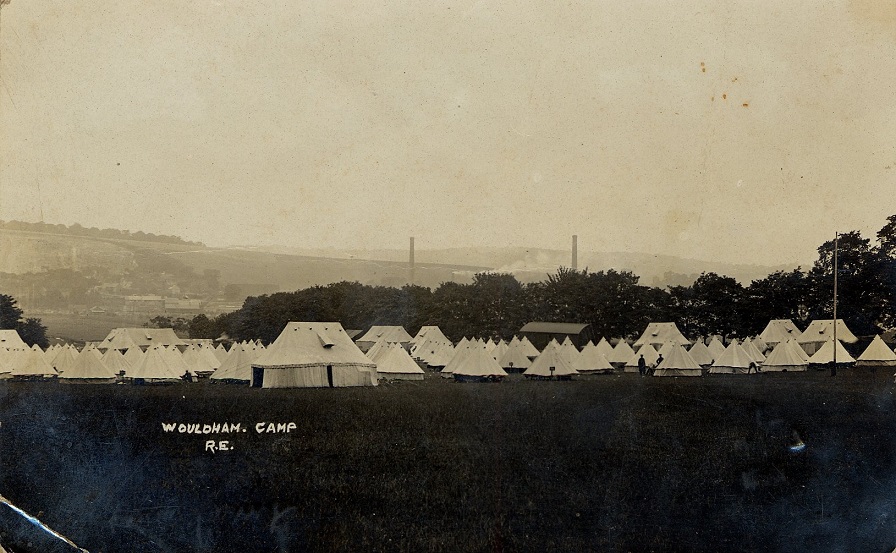The Medals of Company Sergeant Major George Clark DCM R.E.
Distinguised Conduct Medal (EVIIR)
Queen's South Africa Medal
King's South Africa Medal
Long Service and Good Conduct Medal (EVIIR)
The Mayor of Kimberley's Star
Read about it here. Click on the link
Distinguised Conduct Medal (EVIIR)
Queen's South Africa Medal
King's South Africa Medal
Long Service and Good Conduct Medal (EVIIR)
The Mayor of Kimberley's Star
Read about it here. Click on the link
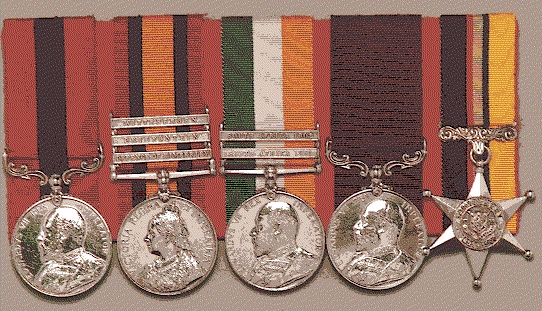
You can read about some of the battles 7 Field Company were engaged in by clicking the link below. Go to the, Great Boer War, and click on these Battles
Siege of Kimberley
The Battle of Belmont & Graspan
Battle of the Modder River
www.britishbattles.com/index.htm
Siege of Kimberley
The Battle of Belmont & Graspan
Battle of the Modder River
www.britishbattles.com/index.htm
The evolution of the Royal Engineers
The Royal Engineers claim descent from William the Conqueror's Military Engineers who were directed in 1066 by Humphrey de Tilleaul. He is depicted in the Bayeaux Tapestry supervising the construction of a fort, transported by sea from Normandy in pre-fabricated sections. The word 'Engineer' derives from the Old French word 'engigneor' meaning one who designs and constructs military engines or works. The medieval records often use the word 'ingeniator' to describe the engineers who were not only skilled builders but also served on the king's campaigns for siege engine duties.
The Normans used a 'shock and awe' strategy to subjugate the native peoples of Britain. 'Shock' in the ferocity of their troops and 'awe' in the pomp of their lieutenants and in the edifices erected by their engineers. The White Tower (1078), now part of the Tower of London, was designed by a King's Engineer, Gundulf, a monk who became Bishop of Rochester. By the reign of Richard I (1189-99) the King's Engineers were reputed to be among the finest castle builders in Christendom thanks to their innovative designs and craftsmanship. They introduced the system of barriers to form a coherent defence system.
In medieval times of war King’s Engineers were responsible for designing and organising the building of siege engines such as belfries (wooden movable siege towers), catapults (engines worked by a lever and rope to discharge darts, stones etc.) and trebuchets (engines for casting heavy missiles using a sling). They also directed the building of roads and river crossings. Edward I had a bridge of boats built to cross the Menai Straits between North Wales and Anglesey. Engineers also dug mines to undermine the foundations of the walls of besieged castles.
The import of gunpowder to Europe from China in the 14th century brought about a radical innovation in warfare, the cannon, and a re-appraisal of fortification design. In 1405, a new department called the Office of Ordnance, with its headquarters and main arsenal in the White Tower at the Tower of London, was established to administer the King's cannon, arsenals and castles, as well as a growing armament industry springing up in London. The Office of Ordnance employed engineers and artillery officers whose numbers were increased in time of war when ‘Ordnance Trains’ were raised. These Trains consisted local artisans, tradesmen and labourers who were capable of assisting the engineers and gunners in their tasks. The Trains were disbanded at the end of each war and their members resumed their peace-time occupations. The Office of Ordnance, renamed the Board of Ordnance, was abolished in1855.
The Royal Warrant of 1683 stated that the Principal Engineer was deemed to be well skilled in all parts of the mathematics, more particularly in Stereometry, Altimetry, and Geodesia, to take Distances, Heights, Depths, Surveys of Land, Measure solid bodies and in all manner of foundations... to be prefect in Architecture, Civil and Military... to have always by him the descriptions or models of all manner of Engines useful in Fortifications or Sieges... to keep perfect draughts of every fortifications, forts and fortresses of our Kingdom... to visit all fortifications in our Kingdoms and to make his report in writing of the condition he finds them in ...to endeavour to provide for our service good and able Engineers, Conductors and Work -Bases... in time of action...to take a careful view of the situation ... to see where the attack or attacks are most advantageously to be made...
In 1704 the British besieged Gibraltar which they eventually captured from the Spanish. Gibraltar was to later play an important part in the development of the Corps.
In the aftermath of the Treaty of Utrecht (1714) that ended the War of Spanish Succession (1701-13) the Trains were again disbanded but Britain found itself in the possession of Gibraltar, Minorca and Nova Scotia. All these territories required extra engineer staff to maintain their defences. At same time it became apparent that the functions of gunnery and engineering were not entirely compatible and that Artillery officers resented being subordinate to Engineers. It was proposed that two distinct Corps be created within the Ordnance: the Royal Regiment of Artillery, responsible for gunnery, and the Corps of Engineers, responsible for military engineering. In 1716 the proposal was implemented by Royal Warrant and the Corps of Engineers was formed and was staffed entirely by officers. A Royal Warrant, dated the 25 April 1787, bestowed the Corps with the 'Royal' title so it became the Corps of Royal Engineers.
On 10 July 1832 William IV granted the Royal Regiment of Artillery and the Corps of Royal Engineers permission to wear, on their appointments, the Royal Arms and Supporters, together with a cannon and the mottoes Ubique (Everywhere) above the cannon and Quo Fas et Gloria Ducunt (Where right and glory lead) below it. In 1868 the cannon was omitted from the Corps Badge. Since then the actual design of the Royal Arms has changed slightly with each reigning monarch.
The French Revolution during the 1790’s, highlighted the British vulnerability of the southern coast of England to attack. This led to the raising of a 'Corps of Royal Military Artificers'. Companies were stationed at: Woolwich, Chatham, Gosport, Plymouth and the Channels Islands, and were not transferable. Royal Military Artificers companies accompanied the British Army fighting the French on the Iberian peninsular:
* Portugal - 5th, 6th, 7th and 8th Companies of 2nd Battalion.
* Cadiz, Spain - 6th and 7th Companies of 1st Battalion.
However, although the members of these companies were expert at constructing static fortifications and other works they had little experience of field (combat) engineering. Their shortcomings became very apparent during the early stages of the Peninsular War wars with France and there were soon calls for improvements.
Royal Engineers and Royal Military Artificers accompanied General Sir John Moore's 1808 campaign to Portugal and Spain. Their first major challenge was to build a great defensive system north of Lisbon, which became known as the Lines of Torres Vedras (1809). Over a period of ten months 182 redoubts were constructed mounting more than 600 guns with a manning capacity of some 40,000. The structures stretched over 25 miles from the lower Tagus to the sea.
It was not until the Duke of Wellington's campaign in the Peninsula, however, that the Engineers came into their own. Major General Sir William Napier later wrote in his History of the War in the Peninsula:
"The engineer officers were zealous; and notwithstanding some defects in the constitution and customs of their corps, tending rather to make regimental than practical scientific officers, many of them were well versed in the theory of their business: yet the ablest trembled at their destitution of all things necessary to real service. Without a corps of sappers and miners, without a private soldier who knew how to carry on an operation under fire, they were compelled to attack fortresses defended by the most warlike, practised, and scientific troops of the age ... The sieges carried on by the British in Spain were a succession of butcheries, because the commonest materials and means necessary for their art were denied to the engineers"
In 1812 General Sir Arthur Wellesley, later Duke of Wellington, requested of the Prime Minister Lord Liverpool that the British Army have a corps of sappers and miners along the lines of the French Army:
"I would beg to suggest to your Lordship the expediency of adding to the Engineers' establishment a corps of sappers and miners. It is inconceivable with what disadvantage we undertake any thing like a siege for want of assistance of this description. There is no French corps d'armee which has not a battalion of sappers and a company of miners. But we are obliged to depend for assistance of this description upon the regiments of the line".
Wellington's despatch to Lord Liverpool (11 February 1812)
The Sieges of Badajoz 1811-1812: Three attempts were made to break the French defences at Badajoz before success was finally achieved on the third attempt in April 1812, where 24 Engineers and 115 Royal Military Artificers were employed on siege works. It was these actions and failures at the earlier sieges of Badajoz that prompted Wellington to request "a sufficient trained corps of sappers and miners" and for Napier to write: "It was strange and culpable that the British Government ... should have sent an engineer corps into the field so ill organised and equipped that all the officers' bravery and zeal could not render it efficient". Sir Charles Oman in his history of the war entitled Wellington's Army held the view that the failure of the Badajoz sieges was due to the shortage of sappers and miners and those responsible for that shortcoming were the professional advisers to the administration, who should have drawn attention to the need of such a corps.
On 23 April 1812 a Royal Warrant authorised the establishment of the 'Royal Engineer Establishment' in Chatham for "the Instruction of the Corps of Royal Military Artificers, or Sappers and Miners, and the junior officers of the Royal Engineers, in the duties of Sapping and Mining and other Military Field Works"
'The Royal Military Artificers, or Sappers and Miners’ were formed on 4 August 1812. Its title was changed in 1813 to the simpler one of 'Royal Sappers and Miners'. In the same year the colour of their dress was changed from blue to scarlet to render the wearers less conspicuous to the enemy when acting with working parties of the line. The new Corps was commanded by the Royal Engineers and trained as field sappers and miners to replace the system of reliance on infantry of the line for field engineering duties. By the end of the Peninsular War in 1814 there were five companies serving with Wellington's Army.
In 1856, the Corps of Royal Sappers and Miners was amalgamated with the Corps of Royal Engineers. The rank of 'Private' in the newly formed Corps of Royal Engineers was changed to 'Sapper' and still exists today.
The Royal Engineers claim descent from William the Conqueror's Military Engineers who were directed in 1066 by Humphrey de Tilleaul. He is depicted in the Bayeaux Tapestry supervising the construction of a fort, transported by sea from Normandy in pre-fabricated sections. The word 'Engineer' derives from the Old French word 'engigneor' meaning one who designs and constructs military engines or works. The medieval records often use the word 'ingeniator' to describe the engineers who were not only skilled builders but also served on the king's campaigns for siege engine duties.
The Normans used a 'shock and awe' strategy to subjugate the native peoples of Britain. 'Shock' in the ferocity of their troops and 'awe' in the pomp of their lieutenants and in the edifices erected by their engineers. The White Tower (1078), now part of the Tower of London, was designed by a King's Engineer, Gundulf, a monk who became Bishop of Rochester. By the reign of Richard I (1189-99) the King's Engineers were reputed to be among the finest castle builders in Christendom thanks to their innovative designs and craftsmanship. They introduced the system of barriers to form a coherent defence system.
In medieval times of war King’s Engineers were responsible for designing and organising the building of siege engines such as belfries (wooden movable siege towers), catapults (engines worked by a lever and rope to discharge darts, stones etc.) and trebuchets (engines for casting heavy missiles using a sling). They also directed the building of roads and river crossings. Edward I had a bridge of boats built to cross the Menai Straits between North Wales and Anglesey. Engineers also dug mines to undermine the foundations of the walls of besieged castles.
The import of gunpowder to Europe from China in the 14th century brought about a radical innovation in warfare, the cannon, and a re-appraisal of fortification design. In 1405, a new department called the Office of Ordnance, with its headquarters and main arsenal in the White Tower at the Tower of London, was established to administer the King's cannon, arsenals and castles, as well as a growing armament industry springing up in London. The Office of Ordnance employed engineers and artillery officers whose numbers were increased in time of war when ‘Ordnance Trains’ were raised. These Trains consisted local artisans, tradesmen and labourers who were capable of assisting the engineers and gunners in their tasks. The Trains were disbanded at the end of each war and their members resumed their peace-time occupations. The Office of Ordnance, renamed the Board of Ordnance, was abolished in1855.
The Royal Warrant of 1683 stated that the Principal Engineer was deemed to be well skilled in all parts of the mathematics, more particularly in Stereometry, Altimetry, and Geodesia, to take Distances, Heights, Depths, Surveys of Land, Measure solid bodies and in all manner of foundations... to be prefect in Architecture, Civil and Military... to have always by him the descriptions or models of all manner of Engines useful in Fortifications or Sieges... to keep perfect draughts of every fortifications, forts and fortresses of our Kingdom... to visit all fortifications in our Kingdoms and to make his report in writing of the condition he finds them in ...to endeavour to provide for our service good and able Engineers, Conductors and Work -Bases... in time of action...to take a careful view of the situation ... to see where the attack or attacks are most advantageously to be made...
In 1704 the British besieged Gibraltar which they eventually captured from the Spanish. Gibraltar was to later play an important part in the development of the Corps.
In the aftermath of the Treaty of Utrecht (1714) that ended the War of Spanish Succession (1701-13) the Trains were again disbanded but Britain found itself in the possession of Gibraltar, Minorca and Nova Scotia. All these territories required extra engineer staff to maintain their defences. At same time it became apparent that the functions of gunnery and engineering were not entirely compatible and that Artillery officers resented being subordinate to Engineers. It was proposed that two distinct Corps be created within the Ordnance: the Royal Regiment of Artillery, responsible for gunnery, and the Corps of Engineers, responsible for military engineering. In 1716 the proposal was implemented by Royal Warrant and the Corps of Engineers was formed and was staffed entirely by officers. A Royal Warrant, dated the 25 April 1787, bestowed the Corps with the 'Royal' title so it became the Corps of Royal Engineers.
On 10 July 1832 William IV granted the Royal Regiment of Artillery and the Corps of Royal Engineers permission to wear, on their appointments, the Royal Arms and Supporters, together with a cannon and the mottoes Ubique (Everywhere) above the cannon and Quo Fas et Gloria Ducunt (Where right and glory lead) below it. In 1868 the cannon was omitted from the Corps Badge. Since then the actual design of the Royal Arms has changed slightly with each reigning monarch.
The French Revolution during the 1790’s, highlighted the British vulnerability of the southern coast of England to attack. This led to the raising of a 'Corps of Royal Military Artificers'. Companies were stationed at: Woolwich, Chatham, Gosport, Plymouth and the Channels Islands, and were not transferable. Royal Military Artificers companies accompanied the British Army fighting the French on the Iberian peninsular:
* Portugal - 5th, 6th, 7th and 8th Companies of 2nd Battalion.
* Cadiz, Spain - 6th and 7th Companies of 1st Battalion.
However, although the members of these companies were expert at constructing static fortifications and other works they had little experience of field (combat) engineering. Their shortcomings became very apparent during the early stages of the Peninsular War wars with France and there were soon calls for improvements.
Royal Engineers and Royal Military Artificers accompanied General Sir John Moore's 1808 campaign to Portugal and Spain. Their first major challenge was to build a great defensive system north of Lisbon, which became known as the Lines of Torres Vedras (1809). Over a period of ten months 182 redoubts were constructed mounting more than 600 guns with a manning capacity of some 40,000. The structures stretched over 25 miles from the lower Tagus to the sea.
It was not until the Duke of Wellington's campaign in the Peninsula, however, that the Engineers came into their own. Major General Sir William Napier later wrote in his History of the War in the Peninsula:
"The engineer officers were zealous; and notwithstanding some defects in the constitution and customs of their corps, tending rather to make regimental than practical scientific officers, many of them were well versed in the theory of their business: yet the ablest trembled at their destitution of all things necessary to real service. Without a corps of sappers and miners, without a private soldier who knew how to carry on an operation under fire, they were compelled to attack fortresses defended by the most warlike, practised, and scientific troops of the age ... The sieges carried on by the British in Spain were a succession of butcheries, because the commonest materials and means necessary for their art were denied to the engineers"
In 1812 General Sir Arthur Wellesley, later Duke of Wellington, requested of the Prime Minister Lord Liverpool that the British Army have a corps of sappers and miners along the lines of the French Army:
"I would beg to suggest to your Lordship the expediency of adding to the Engineers' establishment a corps of sappers and miners. It is inconceivable with what disadvantage we undertake any thing like a siege for want of assistance of this description. There is no French corps d'armee which has not a battalion of sappers and a company of miners. But we are obliged to depend for assistance of this description upon the regiments of the line".
Wellington's despatch to Lord Liverpool (11 February 1812)
The Sieges of Badajoz 1811-1812: Three attempts were made to break the French defences at Badajoz before success was finally achieved on the third attempt in April 1812, where 24 Engineers and 115 Royal Military Artificers were employed on siege works. It was these actions and failures at the earlier sieges of Badajoz that prompted Wellington to request "a sufficient trained corps of sappers and miners" and for Napier to write: "It was strange and culpable that the British Government ... should have sent an engineer corps into the field so ill organised and equipped that all the officers' bravery and zeal could not render it efficient". Sir Charles Oman in his history of the war entitled Wellington's Army held the view that the failure of the Badajoz sieges was due to the shortage of sappers and miners and those responsible for that shortcoming were the professional advisers to the administration, who should have drawn attention to the need of such a corps.
On 23 April 1812 a Royal Warrant authorised the establishment of the 'Royal Engineer Establishment' in Chatham for "the Instruction of the Corps of Royal Military Artificers, or Sappers and Miners, and the junior officers of the Royal Engineers, in the duties of Sapping and Mining and other Military Field Works"
'The Royal Military Artificers, or Sappers and Miners’ were formed on 4 August 1812. Its title was changed in 1813 to the simpler one of 'Royal Sappers and Miners'. In the same year the colour of their dress was changed from blue to scarlet to render the wearers less conspicuous to the enemy when acting with working parties of the line. The new Corps was commanded by the Royal Engineers and trained as field sappers and miners to replace the system of reliance on infantry of the line for field engineering duties. By the end of the Peninsular War in 1814 there were five companies serving with Wellington's Army.
In 1856, the Corps of Royal Sappers and Miners was amalgamated with the Corps of Royal Engineers. The rank of 'Private' in the newly formed Corps of Royal Engineers was changed to 'Sapper' and still exists today.
| Date | Place Event |
|
The Royal Warrant of 6 March 1772 |
This authorized the formation of a Company of Artificers at Gibraltar with an establishment of 68 all ranks (no officers). Within a year, this was increased to 93 all ranks and in 1776 to 116. In 1786 its establishment was raised to 275 and was divided into 2 Companies. 2) The Royal Warrant of 10 October 1787 The Corps of Military Artificers was created for the home establishment. The corps was included in the Mutiny Act of that year. The Warrant created a force of six companies of 100 men each (total 600). The companies were not transferable and their stations were: Woolwich, Chatham, Portsmouth, Gosport, Plymouth, Channel, Islands In 1789 a Colonel-Commandant and Quartermaster were appointed. In 1800 the following stations were occupied: Woolwich Portsmouth Gosport Plymouth Jersey and Guernsey Gibraltar Minorca Nova Scotia West Indies Chatham |
|
The Royal Warrant of 5 September 1806 |
The new establishment was 12 companies of 126 all ranks for a total of 1,514 including staff. The distribution of the companies was as follows: 1st Company - Woolwich 2nd Company - Chatham 3rd Company - Dover 4th Company - Portsmouth 5th Company - Gosport 6th Company - Plymouth 7th Company - Spike Island 8th Company - Channel Islands 9th Company - Gibraltar 10th Company - Gibraltar 11th Company - West Indies 12th Company - Nova Scotia |
|
1807 |
In 1807 the offices of Adjutant and Quartermaster were combined and the headquarters of the corps was established at Woolwich. |
|
The Royal Warrant of 28 May 1811 |
The size of the Corps of Military Artificers was set at 32 companies of 89 all ranks for a total of 2,861 all ranks (this must include a staff of 13). The companies were grouped into 4 battalions each of 8 companies. The companies were no longer localised but removed by rotation from station to station as required. Distribution of Companies: 2 Guernsey and Jersey 2 Cork 2 Plymouth 2 Chatham 6 Woolwich 3 Portsmouth and Gosport 2 Dover 1 Newfoundland 1 Halifax 3 Gibraltar 1 West Indies 2 Cadiz (6th and 7th Companies of 1st Battalion 4 Portugal (5th, 6th, 7th and 8th of 2nd Battalion) This was because of the severe strains on the Corps created by the Peninsular War, which were initially answered by drafts from companies. Expansion was completed by the end of the year. |
|
1812 |
In 1812 a school was set up in Chatham for military fieldwork, since developed into the School of Military Engineering. On 4th August 1812 the Master-General of the Ordnance directed "that the RMA should hereafter be styled the Royal Military Artificers or Sappers and Miners." On 6th March 1813 this was changed to the Royal Sappers and Miners. At the same time the uniforms were changed from blue to scarlet. In 1814 the posts of Adjutant and Quartermaster were split again. |
|
The Peninsular war (1808-1814) July 1814 |
The Peninsular War started when Napoleon's Grande Armee invaded Portugal. The British, Portuguese and Spanish eventually drove the French out of Spain after several hard fought battles. In 1811 7th Company took part in the Peninsular war. For more information on this war click on the link www.britishbattles.com/index.htm Portsmouth |
|
Feb 1815 |
Woolwich |
|
Apr 1815 |
Chatham |
|
Dec 1816 |
Spike Island |
|
Jan 1818 |
Barbados |
|
Nov 1819 |
Re-titled 7 Coy |
|
Jul 1822 |
Woolwich |
|
May 1823 |
Portsmouth |
|
Sep 1827 |
Canada for work on the Rideau Canal (see Royal Engineer history video clip at top right of page) |
|
Nov 1831 |
Reduced to a Cadre |
|
Dec 1831 |
Woolwich |
|
Jan 1832 |
Disbanded 18 Coy - retitled - 7 Coy at Halifax, Novia Scotia |
|
Aug 1836 |
Woolwich |
| May 1837 | Chatham |
| Feb 1838 | Woolwich |
| Jan 1842 | Corfu |
| Apr 1848 | Woolwich |
| 1850 | Chatham |
| Oct 1851 | Portsmouth |
| Jun 1852 | Hurst Castle |
| Feb 1854 | Woolwich |
| Apr 1854 | Turkey ( Gallopili) |
|
Nov 1854 |
The Crimean War (1854-1856) In 1854-55 the Corps of Royal Sappers and Miners had a new establishment of 2,655 by adding 20 men to each company. 4 companies were sent out to the Crimea and allocated as follows: 1st Division - 11th Company 2nd Division - 8th Company 3rd Division - 7th Company 4th Division - 10th Company By 9th May 1855 there were 9 RS&M companies in the Crimea. The extra companies were the 1st, 2nd, 3rd, 4th and 5th. For more information on this war click on the link and look up Crimean War www.britishbattles.com/index.htm |
| Jul 1856 | Devonport |
|
17 Aug 1856 |
On 17th August 1856 the London Gazette announced the transfer of the Corps of Royal Sappers and Miners to the Corps of Royal Engineers. The privates of the RS&M became sappers in the Corps of Royal Engineers. |
|
1856 |
RE Victoria Cross Crimean War Medal entitlement of: Sergeant Major William James LENDRIM 7th Company, Royal Sappers & Miners Victoria Cross Crimea Medal ( 1854-56 ) 1 clasp: "Sebastopol" Indian Mutiny Medal ( 1857-58 ) 1 clasp: "Lucknow" Army Long Service & Good Conduct Medal Medaille Militaire ( France ) Turkish Crimea Medal ( 1855-56 ) 14 FEB.11 APRIL. & 20 APRIL.1855 |
|
May 1857 |
Chatham |
|
Aug 1857 |
Halifax, Nova Scotia |
|
Oct 1862 |
Chatham |
|
Apr 1863 |
Dover |
|
Jan 1866 |
Chatham |
|
Jun 1866 |
Isle of Grain |
|
Jan 1868 |
Chatham |
|
Mar 1868 |
Woolwich |
|
May 1869 |
St Helena - 7 Field Company built the famous Jacob's Ladder in St Helena in 1871 Check it out: https://www.youtube.com/watch?v=lD6-Nm5T-mQ |
|
Jan 1876 |
Cape of Good Hope |
|
1879 |
Re-designated a Field Company and in the Zulu War |
|
Jan 1880 |
Chatham |
|
Mar 1881 |
Natal for 1st Boer War |
|
Feb 1882 |
Aldershot |
|
Nov 1884 |
S. Afrika for Bechuanaland Expedition |
|
Dec 1885 |
Chatham |
|
May 1886 |
Curragh |
|
May 1888 |
Aldershot |
|
1887-1888 |
New companies were formed after the Crimean War as follows: 27th Company RE - November 1856, 28th Company RE - December 1856, 29th Company RE - February 1857 30th Company RE - March 1857, 31st Company RE - April 1857, 32nd Company RE - April 1857 The Field Companies In 1877 the 2nd, 5th, 17th and 31st Field Companies were created, as part of the organisation of the field army into Army Corps. In May 1885 the field companies were increased to 6 (7th, 11th, 12th, 23rd, 24th and 26th). In November 1885 the 17th Company exchanged places with the 11th. In the Army Estimates 1887-88 the 17th, 37th and 38th Companies were converted to field companies. This was to provide the field army with enough field engineers for 2 Army Corps organised into 2 field battalions as follows. 1st Field Battalion, RE (7th, 11th, 17th and 23rd Field Companies, RE) with the 1st Army Corps. 2nd Field Battalion, RE (12th, 26th, 37th and 38th Field Companies, RE) with the 2nd Army Corps. |
|
Jun 1893 |
Chatham |
|
1896 |
The Curragh, Ireland 1896 Early 1896 7th Field Company moved to the Curragh in Co Kildare, Ireland by mid-1899 it became apparent that the clouds of war were gathering in South Africa and 7 Field Company was alerted for deployment to the Cape. |
|
1899 |
South Africa 1899-1902 On the 14th of July 1899 the 7th Field Company left the Curragh bound for Southampton. The Company strength was 6 officers, 180 non-commissioned officers and men, and 30 horses. The company was commanded by Brevet Lieutenant Colonel W.F.H.S. Kincaid. The Second in Command was Captain F.R.F. Boileau The company embarked on board the Braemar Castle on the 15th of July 1899 bound for the Cape Colony where it would initially be assigned to serve with Corps Troops. The Braemar Castle arrived at Cape Town on the 5th of August and after disembarking the entire company was sent to Wynberg Camp where it was employed on the construction of accommodation for other British troops soon to arrive from England On the 18 September 1899, No1 section under LT McClintock was sent to Kimberly. Sometime later, 7th Field Company were assigned to Lord Methuen's column for the relief of Kimberley. The engineer units with this column consisted of the 7th and 11th Field Companies, the 8th Railway Company, the 31st Fortress Company, and a Telegraph Section, all under the command of Lieutenant Colonel J.B. Sharpe, R.E. as the Commander Royal Engineers (C.R.E.). The move northward commenced from Orange River Station on the 21st of November 1899 and by the afternoon of the following day the division arrived within 2 miles of Belmont Railway Station where the Boers decided to make their first stand on a range of hills commanding the railway. The Boers were driven from this position on the 23rd of November and the advance was continued. The Royal Engineers were assigned the task of repairing the railway that had been considerably damaged by the Boers before they retreated. On the 25th of November the Boers made a further stand at Graspan and then retired to the Modder River. On the 28th, 7th Field Company was pushed on with an escort to endeavour to save the railway bridge over the Modder. The company was greeted by a salvo from the Boer artillery that had taken up a position on the north bank of the river. 7 Field Company soon discovered that the bridge had been destroyed. The Royal Engineers of the column were given the task of constructing a temporary bridge, a difficult task that was completed by the 10th of December. (see photo opposite) On the 11th of December 1899, 7th Field Company was attached to the Brigade of Guards and took part in the right attack during the unsuccessful Battle of Magersfontein. Following this battle, Lord Methuen decided to hold his ground along the Modder River to await further developments with regard to the movements of the Boer forces and other British forces in the area. British offensive operations began again on the 12th of February 1900 with 7 Field Company attached to the newly formed 9th Infantry Division under Lieutenant General Sir H.E. Colville. Following the relief of Kimberley the British force began operations to capture the Boer forces in the laager near Paardeberg Drift which were under the command of General Cronje. Trenches were commenced and pushed forward towards the laager. By the 26th of February the 19th Brigade and 7 Field Company had made a trench nearly 500 yards long on the right bank of the Modder as well as another trench on the left bank of the river. The Boer entrenchments were assaulted that night by the 19th Brigade, of which the Royal Canadian Regiment and a detachment of 7 Field Company formed the vanguard. The men of 7 Field Company got within 100 yards of the Boer trenches without being observed, and then, at about 3 a.m., a heavy fire was opened upon them and the sappers with some of the Canadians succeeded in entrenching themselves close to the enemy's lines. By 5 a.m. the trench was completed and fire was opened at short range on the Boers, who, after defending themselves for a time, made proposals for surrender. The action of 7 Field Company in this battle was highly commended by Lord Roberts, who inspected them the same day and congratulated them on their gallant conduct. 7th Field Company continued the advance on the 6th of March 1900 with the Highland Brigade of the 9th Division. On the 13th of March the British forces entered Bloemfontein. By the beginning of May 1900 Lord Roberts completed his preparations for the invasion of the Transvaal and gave orders for the advance. 7 Field Company marched with the 9th Division on the 3rd of May. The company, which was attached to the Highland Brigade, reached Winburg on the 6th of May and immediately fortified the town for defensive operations. The next operation undertaken was the capture of Johannesburg which was preceded, on the 29th of May, by an attack on Doomkop by the 19th Infantry Brigade to which a section of 7 Field Company, commanded by Lieutenant E.E.B. Wilson, was attached. Fighting continued in the northeast of the Orange Free State during June and July of 1900, and the Boers were gradually driven back. The Boers retired to the Brandwater Basin, a mountainous district lying between the Wittebergen and Roodebergen Hills and the Caledon River. The work of the Royal Engineers during these operations, including 7 Field Company, was to block the mountain passes to prevent the Boer escaping. By the 1st of September 1900 the regular campaign in South Africa was over. What followed from this point was a series of small guerrilla type operations for which the Royal Engineer field companies were broken up into small sections and detachments. |
|
1902 |
Aldershot 1902-1905 On the 28th of September 1902 7th Field Company arrived in Aldershot where they were to be stationed. Only 3 officers and 45 other ranks of the original company returned to Aldershot. One officer (Lieutenant Trench) and 12 non-commissioned officers and men had died in South Africa, the remainder being transferred or invalided. |
|
Apr-Aug 1905 |
Temporary duty at Trawsfynnyd |
|
1906 |
Shorncliffe Kent in 1906 7th Field Company was serving at Shorncliffe in Kent in 1906 |
|
1907 |
In 4 Division |
|
1914 |
The Company left Shorncliffe August 1914 for France as part of the B.E.F. with 4 Divsion |
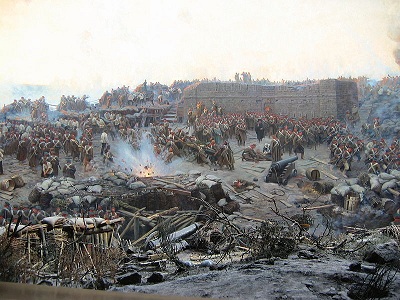
A panoramic view of the seige of Sebastopol
The origins of Shiny 7 date back more than 200 years. Since its inception, Shiny 7 has participated in every major campaign/war the British Army has been involved in, and fought many battles along the way. Many military honours have been awarded to its members throughout the different eras, including the Victoria Cross. The courage and valour of our predecessors has to be greatly admired, especially when working in the harsh and unpleasant conditions they had to endure. All those who have served in Shiny 7 can be immensely proud of its untouchable history. It is a pity we were never made aware of the Squadron’s history when we joined it. The Squadron would see benefits, if everyone joining the Squadron were given a copy of its history to read as part of their induction, they would take inspiration from it.

The Peninsular War Map

Royal Sappers and Miners uniform and work dress 1825
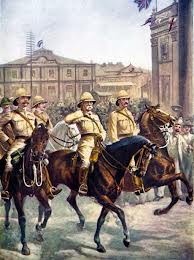
Lord Roberts enters Kimberley after the Seige
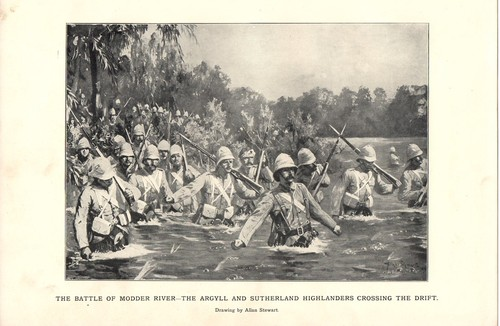
Battle of the Modder River
Royal Engineer history video clip
Cpl William Lendrim VC
He was 25 years old, and a Corporal in the 7th Company Royal Sappers & Miners during the Crimean War when the following deed took place for which he was awarded the VC.
On 14 February 1855 during the Siege of Sevastopol, Crimea, Corporal Lendrim superintended 150 French Chasseurs in building No 9 Battery left attack and replacing the whole of the capsized gabions under a heavy fire. On the 11 April he got on top of a magazine under fire, and extinguished burning sandbags, making good the breach. On 20 April he was one of four volunteers who destroyed the screen which the Russians had erected to conceal their advance rifle-pits.
He was 25 years old, and a Corporal in the 7th Company Royal Sappers & Miners during the Crimean War when the following deed took place for which he was awarded the VC.
On 14 February 1855 during the Siege of Sevastopol, Crimea, Corporal Lendrim superintended 150 French Chasseurs in building No 9 Battery left attack and replacing the whole of the capsized gabions under a heavy fire. On the 11 April he got on top of a magazine under fire, and extinguished burning sandbags, making good the breach. On 20 April he was one of four volunteers who destroyed the screen which the Russians had erected to conceal their advance rifle-pits.
Above: 7 Field Company R.E. in South African War. Extracts from letters by Lt Wilson of No 2 Section written after victory at Graspan and on capture of Bloemfontein
When viewing the thumbnails to move to the next page, simply run the pointer up the right side of the page and click on 'next' to go back, run the pointer on the left of the page.To exit click bottom right of any page
When viewing the thumbnails to move to the next page, simply run the pointer up the right side of the page and click on 'next' to go back, run the pointer on the left of the page.To exit click bottom right of any page
Route of 7 Field Company Oct 1899 - Apr 1900

Shiny 7 History Page One 1800 - 1913

Source Re- Museum. http://www.re-museum.co.uk/
History of the Shiny 7th
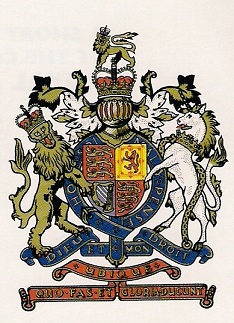
The Shiny 7th - A history to be proud of
The Corps Badge (The Royal Arms)
granted by King William IV in 1832
granted by King William IV in 1832
RE Cap Badges during this period
Early Victorian
Victorian circa 1850
Victorian Volunteers 1860-1901
Late Victorian
King Edward VII 1901-1910
King George V 1910-1936
King George V WW1
The Shiny 7 Name Adoption Theories click on the thumb nails below
NCOs of 7 Field Company RE in Curragh Camp Ireland 1897
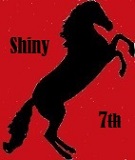

'Pontoon bridge built by Royal Engineers in two hours across the River Modder'
On 21 November 1899 the British 1st Division under Lord Methuen began its advance north from the Orange River to relieve Kimberley. On reaching the Modder River, the 7th and 11th Field Companies, Royal Engineers, constructed a temporary bridge which was completed on 10 December 1899.
On 21 November 1899 the British 1st Division under Lord Methuen began its advance north from the Orange River to relieve Kimberley. On reaching the Modder River, the 7th and 11th Field Companies, Royal Engineers, constructed a temporary bridge which was completed on 10 December 1899.
Sappers embarking for South Africa 1912 (not 7 Coy). This appears to be a RE Tool Cart.
The 7th Field Company was known as the "Black Horse". The origin of the name appearing to date from about 1885 when all the company horses were black

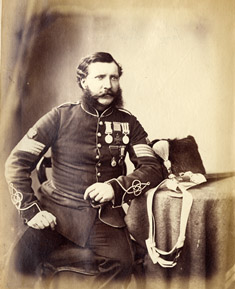
Read a short extract on The Royal engineers in the Boer War. 7 Field Company is mentioned:
http://www.boer-war.com/Military/British/RoyalEngineers.html
http://www.boer-war.com/Military/British/RoyalEngineers.html
7 Field Company was so first called in 1806 when Companies of Artificers were first numbered, though the Company was probably raised in 1793 for the war in Flanders. The numbers were not, however, much used at this time, the Companies being more usually known by the name of their stations. In 1811 the Corps was reorganised into eight Company Battalions and the Company history becomes obscure.
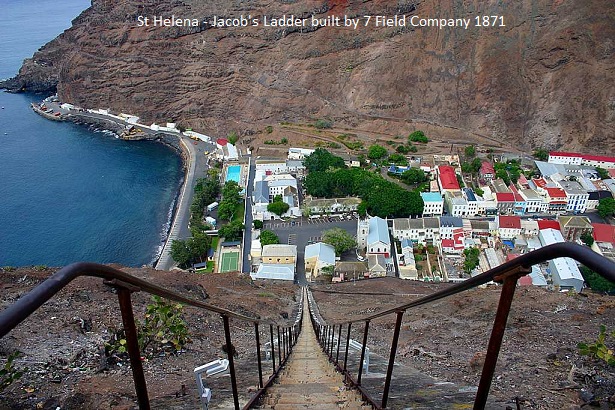
Jacobs Ladder: https://www.youtube.com/watch?v=lD6-Nm5T-mQ
Jacob's Ladder - 699 steps - built to take supplies from the port to the fort
in 1871 by 7 Field Company RE
in 1871 by 7 Field Company RE
The Black Horse
The 7 Field Company was known as the “The Black Horse” Company up until sometime between the WW1 and WW2. The origin of this name is difficult to trace accurately, but appears that, at least as far back as 1885, the Company was known by this name owing to the colour of its horses. Whether or not the name was copied from the 7th Dragoon Guards who are known as the “Black Horse”, it is difficult to say, but there seems no harm in preserving the old name which has stuck to the Company for so long
Written by H.A. Baker formerly Lt H. A .Baker MC, of 7 Field Company RE 1915-1918
Dover 1931
The 7 Field Company was known as the “The Black Horse” Company up until sometime between the WW1 and WW2. The origin of this name is difficult to trace accurately, but appears that, at least as far back as 1885, the Company was known by this name owing to the colour of its horses. Whether or not the name was copied from the 7th Dragoon Guards who are known as the “Black Horse”, it is difficult to say, but there seems no harm in preserving the old name which has stuck to the Company for so long
Written by H.A. Baker formerly Lt H. A .Baker MC, of 7 Field Company RE 1915-1918
Dover 1931
The War in Crimea 1854-56
7 Field Company landed in Gallipolli on April 8th 1854, commanded by Captain C.J.Gibb RE and was for some time employed on landing piers, log huts for hospitals, stables etc at base port. On the 7th of December the Company moved to Sevastopol, its strength being 3 officers and 86 men. The Company brought 400 gabions and large numbers of sandbags, which were very welcome at the siege, where revetting materials had hitherto been very short, the sappers having to use stones for the purpose. In January 1855 very severe frosts set in and this was most detrimental to the work as the troops brought to the trenches coffee, which for some unaccountable reason had been sent unroasted and other articles that required cooking. For this purpose they made use of brushwood from gabions and fascines and anything in the way of fuel they could lay their hands on, even pick elves becoming scarce. In fact the diary of the siege shows that the sappers had to labour under great difficulties, but nevertheless carried on with their customary zeal and cheerfulness. At this time a section, or more accurately a squad, was termed a brigade and consisted of 1 NCO and 8 men. The doing of he doings of the Company in the siege are too varied and too intricate to relate, but the sappers were mainly acting as overseers to infantry and Turkish labour, doing the actual skilled work of laying gabions, sandbags themselves.
Galantry Awards
Victoria Cross
Cpl William. J. Lendrim VC for intrepidity getting on top of a magazine and extingquishing sand bags which were burning and making good the breach under fire, April 11th 1885. For courage and praiseworthy example in superintending 150 French Chasseurs on 14th February 1885, in building No 9 battery left attack and replacing the whole of the capsized gabions under heavy fire. Was one of the four volunteers for destroying the furthest rifle pit on April 20th .
Medal for Distinguished Service in the Field
Spr William Bruce and Spr Neil McInnis.
Mentioned in Despatches
Lt Anderson and Lt Drake
And strongly recommended for reward but without result.
Written by H.A. Baker formerly Lt H. A .Baker MC of 7 Field Company RE 1915-1918
Dover 1931
7 Field Company landed in Gallipolli on April 8th 1854, commanded by Captain C.J.Gibb RE and was for some time employed on landing piers, log huts for hospitals, stables etc at base port. On the 7th of December the Company moved to Sevastopol, its strength being 3 officers and 86 men. The Company brought 400 gabions and large numbers of sandbags, which were very welcome at the siege, where revetting materials had hitherto been very short, the sappers having to use stones for the purpose. In January 1855 very severe frosts set in and this was most detrimental to the work as the troops brought to the trenches coffee, which for some unaccountable reason had been sent unroasted and other articles that required cooking. For this purpose they made use of brushwood from gabions and fascines and anything in the way of fuel they could lay their hands on, even pick elves becoming scarce. In fact the diary of the siege shows that the sappers had to labour under great difficulties, but nevertheless carried on with their customary zeal and cheerfulness. At this time a section, or more accurately a squad, was termed a brigade and consisted of 1 NCO and 8 men. The doing of he doings of the Company in the siege are too varied and too intricate to relate, but the sappers were mainly acting as overseers to infantry and Turkish labour, doing the actual skilled work of laying gabions, sandbags themselves.
Galantry Awards
Victoria Cross
Cpl William. J. Lendrim VC for intrepidity getting on top of a magazine and extingquishing sand bags which were burning and making good the breach under fire, April 11th 1885. For courage and praiseworthy example in superintending 150 French Chasseurs on 14th February 1885, in building No 9 battery left attack and replacing the whole of the capsized gabions under heavy fire. Was one of the four volunteers for destroying the furthest rifle pit on April 20th .
Medal for Distinguished Service in the Field
Spr William Bruce and Spr Neil McInnis.
Mentioned in Despatches
Lt Anderson and Lt Drake
And strongly recommended for reward but without result.
Written by H.A. Baker formerly Lt H. A .Baker MC of 7 Field Company RE 1915-1918
Dover 1931
More on the 7th at Sebastopol
Corporal William James Lendrim (1 January 1830 – 28 November 1891) rose to Serjeant-Major William James Lendrim, V.C.
Corporal Lendrim was the first non-Officer Royal Engineer soldier (at that time he would have been a corporal in the Royal Sappers and Miners) to be awarded the V.C. He was awarded it for several acts of bravery in the trenches around Sebastopol.
On the 14th of February 1855, Lendrim was leading a party of 150 French Chasseurs. They were engaged in building No. 9 Battery ‘left attack,’ an eight gun battery, situated close to a chosen advance point. The battery was protected by large gabions that were being repeatedly attacked and may of the gabions were capsized. Repairing the damage to the gabions, under fire, was very dangerous. Lendrim accepted this undertaking - leading his men under fire from gabion to gabion, ensuring all were repaired. The officer in charge was in no doubt that Lendrim's actions had saved the battery.
On the 11th April a 21 gun battery was under heavy attack from Russian artillery, resulting in a large number of casualties. A live shell hit the magazine roof, setting on fire sandbags that were very close to a 68 pounder gun. Lendrim immediately volunteered to extinguish the fire, leapt on to the roof, under fire, removed the burning sandbags and made good the breach.
On the 20th April, Corporal Lendrim was one of four volunteers that charged a Russian rifle pit directly, quickly clearing it and destroying the screen which the Russians had erected to conceal their advance rifle-pits, before occupying the rifle-pit. This was done in efforts to consolidate British and French gains of the 'right attack' and became the third action that contributed to his V.C.
He was born Carrick-on-Shannon, County Leitrim, Ireland on the 1st January 1830. He joined the Royal Sappers and Miners in 1847. He also served in the Indian Mutiny, and later achieved the rank of Sergeant-Major, and worked at the Staff College, Frimley, serving until 1871. He married Louisa and had 11 children - all alive in 1881.
He was initiated in Lodge of the Thirty-seventh Company of Royal Engineers, No. 963 on 8 July 1863 and passed on 12 August the same year. As the Lodge warrant was withdrawn on 22 February 1864, he was raised in United Chatham Lodge of Benevolence, No. 184, Chatham on 12 April 1864, resigning in November the same year. He was the first Junior Warden of the Albert Edward Lodge No. 1714 chartered by the United Grand Lodge of England in the Province of Surrey in 1877, and its third Worshipful Master in 1879. He was appointed to Provincial Grand Steward in the Province of Surrey in 1878, and Provincial Grand Pursuivant of Surrey in 1881.
William died Camberley, Surrey, on the 28th November 1891 and is buried at the Royal Military Academy Cemetery, plot 182. William also received the Légion d'honneur and Médaille militaire of France.
His Victoria Cross and other awards are displayed at the Royal Engineers Museum.
Corporal William James Lendrim (1 January 1830 – 28 November 1891) rose to Serjeant-Major William James Lendrim, V.C.
Corporal Lendrim was the first non-Officer Royal Engineer soldier (at that time he would have been a corporal in the Royal Sappers and Miners) to be awarded the V.C. He was awarded it for several acts of bravery in the trenches around Sebastopol.
On the 14th of February 1855, Lendrim was leading a party of 150 French Chasseurs. They were engaged in building No. 9 Battery ‘left attack,’ an eight gun battery, situated close to a chosen advance point. The battery was protected by large gabions that were being repeatedly attacked and may of the gabions were capsized. Repairing the damage to the gabions, under fire, was very dangerous. Lendrim accepted this undertaking - leading his men under fire from gabion to gabion, ensuring all were repaired. The officer in charge was in no doubt that Lendrim's actions had saved the battery.
On the 11th April a 21 gun battery was under heavy attack from Russian artillery, resulting in a large number of casualties. A live shell hit the magazine roof, setting on fire sandbags that were very close to a 68 pounder gun. Lendrim immediately volunteered to extinguish the fire, leapt on to the roof, under fire, removed the burning sandbags and made good the breach.
On the 20th April, Corporal Lendrim was one of four volunteers that charged a Russian rifle pit directly, quickly clearing it and destroying the screen which the Russians had erected to conceal their advance rifle-pits, before occupying the rifle-pit. This was done in efforts to consolidate British and French gains of the 'right attack' and became the third action that contributed to his V.C.
He was born Carrick-on-Shannon, County Leitrim, Ireland on the 1st January 1830. He joined the Royal Sappers and Miners in 1847. He also served in the Indian Mutiny, and later achieved the rank of Sergeant-Major, and worked at the Staff College, Frimley, serving until 1871. He married Louisa and had 11 children - all alive in 1881.
He was initiated in Lodge of the Thirty-seventh Company of Royal Engineers, No. 963 on 8 July 1863 and passed on 12 August the same year. As the Lodge warrant was withdrawn on 22 February 1864, he was raised in United Chatham Lodge of Benevolence, No. 184, Chatham on 12 April 1864, resigning in November the same year. He was the first Junior Warden of the Albert Edward Lodge No. 1714 chartered by the United Grand Lodge of England in the Province of Surrey in 1877, and its third Worshipful Master in 1879. He was appointed to Provincial Grand Steward in the Province of Surrey in 1878, and Provincial Grand Pursuivant of Surrey in 1881.
William died Camberley, Surrey, on the 28th November 1891 and is buried at the Royal Military Academy Cemetery, plot 182. William also received the Légion d'honneur and Médaille militaire of France.
His Victoria Cross and other awards are displayed at the Royal Engineers Museum.
Gillingham ME7. Lendrim Close, named after Cpl William J. Lendrim VC
Zulu War 1879
The annexation of the Transvaal in 1878 lead to the disastrous war in 1879. The 7TH Field Company was in South Africa at the time, under the command of Major F.W.Nixon RE, who had with him Lieutenants F.H. MacDowel, and J. Clarke. The Company appears to have been much split up at this time and it is difficult to trace the movements of different detachments. In the disastrous affair at Isandlwana where 52 officers and 806 men lost their lives, Lt MacDowell was killed and also four sappers - the whole of the RE with the column. In this action 16 officers and 400 men out of 16 officers and 403 men of the 1st Battalion, the 24 Regiment and the whole Company of the 2nd Battalion present was killed. At Fort Kambula Sgt Wood and 10 sappers of the 7th Company was present. At Fort Ulundi, Sgt Wood and 6 sappers fought in the square during the battle, Sgt Wood being wounded. In the battle which ended the war, some 1,900 white officers and men and 540 natives was attacked by 20,000 Zulus, of whom only about half got close enough to take part. It was however, a fine example of British Square fighting and the Company should feel proud to have taken part of it.
Written by H.A. Baker formerly Lt H. A .Baker MC of 7 Field Company RE 1915-1918
The annexation of the Transvaal in 1878 lead to the disastrous war in 1879. The 7TH Field Company was in South Africa at the time, under the command of Major F.W.Nixon RE, who had with him Lieutenants F.H. MacDowel, and J. Clarke. The Company appears to have been much split up at this time and it is difficult to trace the movements of different detachments. In the disastrous affair at Isandlwana where 52 officers and 806 men lost their lives, Lt MacDowell was killed and also four sappers - the whole of the RE with the column. In this action 16 officers and 400 men out of 16 officers and 403 men of the 1st Battalion, the 24 Regiment and the whole Company of the 2nd Battalion present was killed. At Fort Kambula Sgt Wood and 10 sappers of the 7th Company was present. At Fort Ulundi, Sgt Wood and 6 sappers fought in the square during the battle, Sgt Wood being wounded. In the battle which ended the war, some 1,900 white officers and men and 540 natives was attacked by 20,000 Zulus, of whom only about half got close enough to take part. It was however, a fine example of British Square fighting and the Company should feel proud to have taken part of it.
Written by H.A. Baker formerly Lt H. A .Baker MC of 7 Field Company RE 1915-1918
The 160th anniversary of Cpl William James Lendrim VC awarded the Victoria Cross 14 February 1855 - 14 February 2015
Wreath laid and photos taken 14 February 2015
Text on the card reads:
In grateful memory of Sergeant-Major William James Lendrim VC, whom as a Corporal serving with the 7th Company Royal Sappers and Miners in the Crimean War, was awarded the Victoria Cross for gallantry on 14 February 1855.
160th Anniversary 14/02/1855 - 14/02/2015.
From The Shiny Seven Association, and on behalf of all ranks past and present who have served in the 7th
www.shinysevenassociation.webs.com
In grateful memory of Sergeant-Major William James Lendrim VC, whom as a Corporal serving with the 7th Company Royal Sappers and Miners in the Crimean War, was awarded the Victoria Cross for gallantry on 14 February 1855.
160th Anniversary 14/02/1855 - 14/02/2015.
From The Shiny Seven Association, and on behalf of all ranks past and present who have served in the 7th
www.shinysevenassociation.webs.com
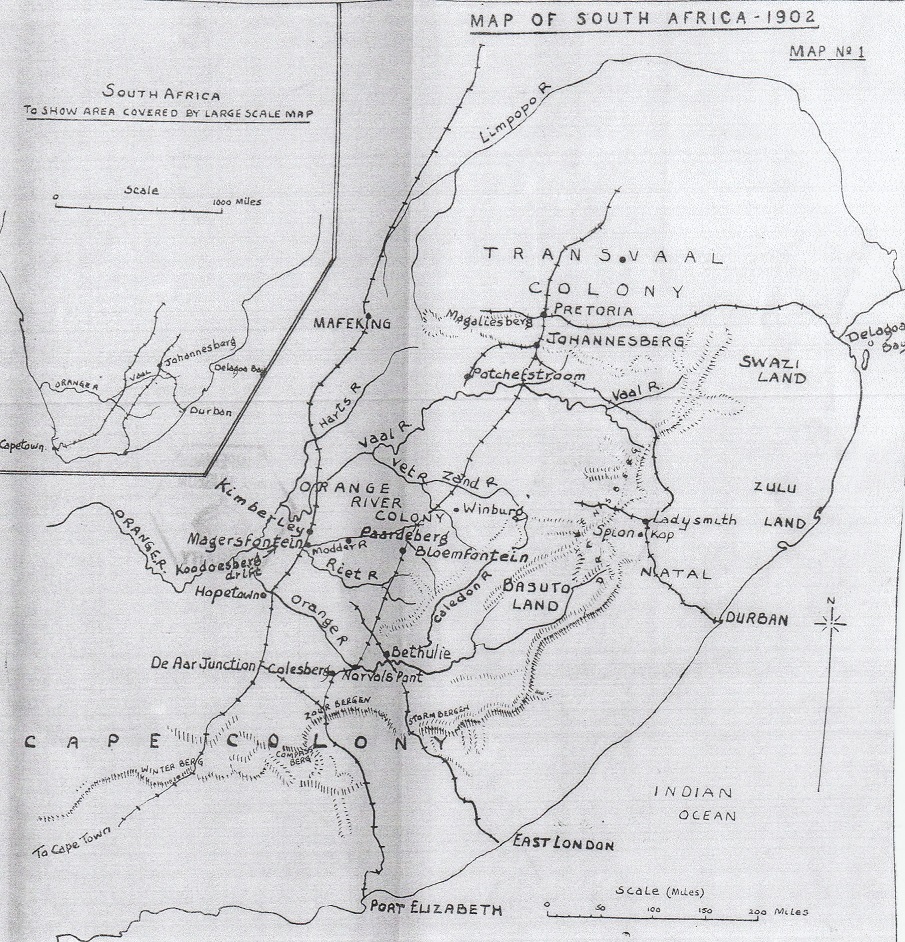

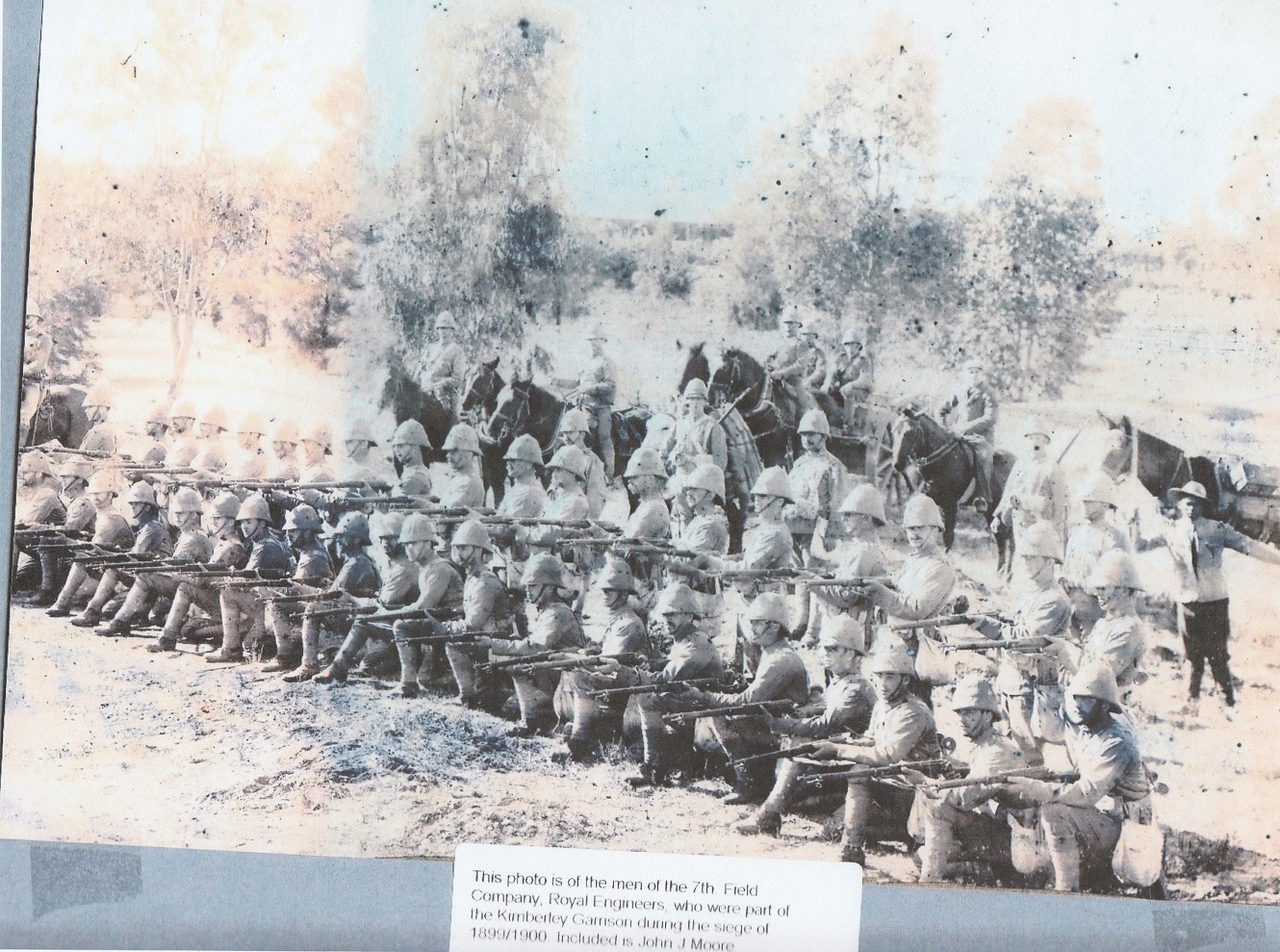
Photo below kindly supplied by Mr Martin Moore who is currently researching 7 Field Company prior to and during the Boer war.
7 Field Company were based in Ireland prior to the Boer war.
If you are able to assist with his research please email: mooreaccountants@eircom.net
7 Field Company were based in Ireland prior to the Boer war.
If you are able to assist with his research please email: mooreaccountants@eircom.net
Below: photos, early Wouldham Bridging Camps on the River Medway


Right: This photo was with a diary written by Pioneer J. E. Daniels,
7 Field Company RE,
August 1914 to April 1915.
Pioneer Daniels is third from the right standing.
Photo courtesy Carol Watt
7 Field Company RE,
August 1914 to April 1915.
Pioneer Daniels is third from the right standing.
Photo courtesy Carol Watt
